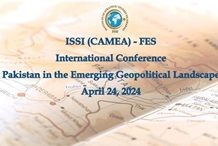Changing ground realities in the Asian theatre
The world is fast reshaping. New centres of gravity are emerging. Regional re-grouping of like-minded policies is underway. It is a new “ideological” divide based upon new geo-strategic realities. The United States, Japan, and India are forming a geo-strategic axis in Asia-Pacific under the US pivot to Asia to re-balance relations to cope with emerging ascendency challenging their writ in world’s affairs.
Japan has assumed more responsibilities as an ally. It is now a military power to support US policies in Asia. Together with tactfully retaining ‘de-militarisation’ article of its post-war Constitution, Japanese army will collectively take part in world’s conflicts. The re-emergence of Japan as a military power and as an American ally matters significantly.
Japan’s Maritime Self Defence Forces will join the American and Indian navies at Malabar in the Bay of Bengal. Japan has become a permanent member of the joint annual naval drill between USA and India. Earlier, Japan had joined these drills as a foreign invitee. This is a shift reflecting Japanese legislation allowing its military to take part in peace and conflicts zones around the world.
Other than the United States, under the joint naval drill, Japan’s defence relations will be more fortifying with India. Japan is also negotiating with India to supply it with civil nuclear power plants since 2010. Australia and Singapore also participated in the Malabar naval exercises.
These naval exercises show great convergence of strategic ties between these nations against the peaceful rise of China in Asia-Pacific and US’ so-called move of freedom of navigation in South China Sea. The move is entirely against China. The United States and its allies will contain China strategically but they have no options to contain China economically. All these nations, however, have strong economic relations with China.
Remilitarisation of Japan did not send good messages to East Asian nations. China has also noticed Japan’s move to revive its militancy of wars. The two Koreas strongly reacted and warned Japan of not sending troops to the Korean Peninsula to settle disputes. Relations with Russia got further tense. The Russians did not show any interests in what the Japanese have to say in the dispute over eighteen Kuril Islands taken by the USSR at the end of 1945. The Japanese claim the ownership of these islands but the Russians deny.
At the same time, Japan’s defence relations with Pakistan will be further drifting away and even engulfing economic ties between the two nations. Both nations used to have excellent diplomatic and economic ties during the Cold War. Now both are drifting away under the new geo-strategic paradigm shift.
It is a good opportunity for Pakistan to enhance its strategic interaction with China, Central Asian Republics, and Russia, on the other hand, for security and economic reasons. Pakistan’s relations with East European countries such as with Belarus are going in the right direction.
China is responding to US pivot to Asia in a powerful manner. China is moving in a big way in Eurasian continent. China’s move towards west brings many regional economies together as China also wants to develop its western regions and its western allies (Pakistan, Iran, and Central Asia), onward to many East European nations that are facing enormous economic constraints since their break up with the USSR in the early 1990s. The West has not offered them much help.
China is emerging as a beacon of hope for these countries. Many of them have joined China’s “One Belt One Road” initiative and its Asian Infrastructure Investment Bank (AIIB). Central Asia is a bridge between China and Europe. China understands its vital significance. Four Central Asian Republics (Tajikistan, Kyrgyzstan, Uzbekistan, and Kazakhstan) are knitted with China in the Shanghai Cooperation Organisation (SCO). China is playing a great role in developing these economies. China unveiled its “One Belt One Road” initiative in Central Asia when President Xi Jinping was on visit to Kazakhstan in 2013.
The China-Pakistan Economic Corridor (CPEC) is an exclusive long-term economic plan to develop the economy of Pakistan and to convert it into a regional hub for China and landlocked Central Asia Republics. Iran and Russia have also shown interest to join the CPEC. The landlocked Mongolia could also benefit from the vitality of the CPEC.
On the other hand, China and Russia are fulfilling each other’s needs. This is a grand partnership from Pacific to Eurasia and Russia is facilitating and giving way to China in Eurasian region.
A new bi-polarity is fast emerging with Asia as the centre piece of gravity. The United States and Russia are both concentrating on Asian powers to increase their sphere of influence. Japan and India are increasing their mutual stakes. So are China and Pakistan with Russia’s cooperation.
Views expressed are of the author and do not necessarily reflect the views of ISS or of the Government of Pakistan.












